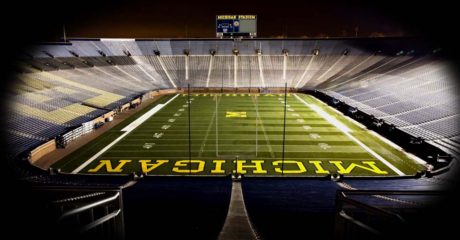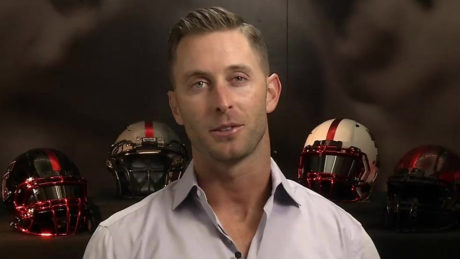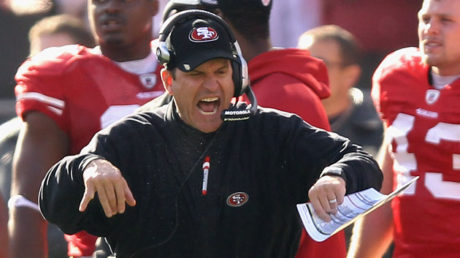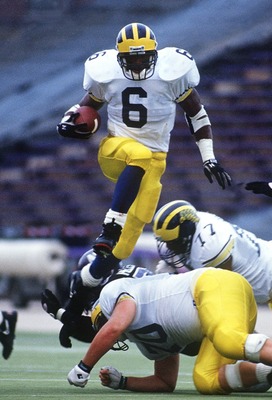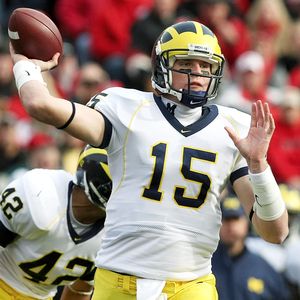Jim Harbaugh, Wolverine (again)
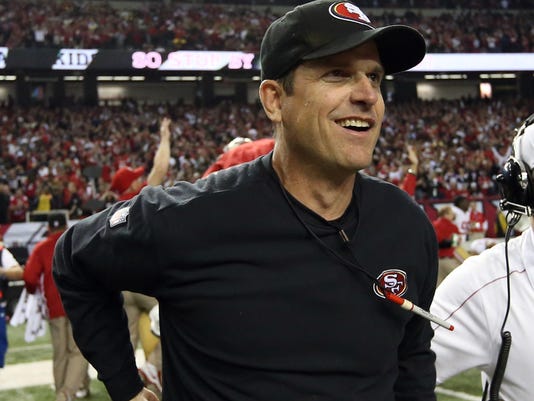 |
| Jim Harbaugh |
Today Michigan is expected to announce that they have signed Jim Harbaugh to be the next head coach. After finishing up his tenure as the San Francisco 49ers head coach with a win on Sunday, he and the 49ers “mutually agreed” to part ways. Harbaugh hopped on a plane on Monday to head to Ann Arbor, and he reportedly signed the contract last night. Several NFL teams were reported to be interested, including the across-the-bay Oakland Raiders, who made overtures to Harbaugh but were turned down.
I already posted a somewhat in-depth summary of Harbaugh’s career and accomplishments (LINK), so I won’t rehash most of that info. Harbaugh played for Bo Schembechler at Michigan in the 1980’s, went on to a successful but unspectacular NFL career, turned around programs at San Diego and Stanford as a head coach, and then had a good four-year run with the 49ers. Despite making it to three straight NFC championship games – and one Super Bowl – the wheels came off during the 2014 season, when Harbaugh’s clashes with the front office became public and the team fell to 8-8, missing the playoffs. It had been understood for half the season that Harbaugh would not return, regardless of how the season turned out.
In my ranking of viable coach options, Harbaugh was #1 on my list for numerous reasons. First and foremost, I guess, is that Harbaugh embodies what Michigan’s administration, fans, and alumni want. He is demanding and intense, and for a program that deifies Bo Schembechler, that intensity pairs nicely. Harbaugh’s competitiveness showed during his career. He was never the fastest guy or the most accurate or the one with the strongest arm, but he was a Heisman contender as a senior and scrapped as a pro football player and coach to try to get to the highest levels.
Another somewhat nice thing about Harbaugh is that his desired personnel and systems are already mostly in place. He had to rebuild at San Diego and Stanford, while the 49ers job had some decent talent already in place. Either way, he wants to run the ball, pass efficiently, and play good defense. Michigan has recruited and developed the roster to do just those things. There are a couple highly touted running backs on the roster, some big-time recruits on the offensive line, some solid tight ends, and good defensive players at every level returning in 2015. The question marks are at quarterback and wide receiver, but a commitment to running the ball should take some of the pressure off of whoever wins the QB job. Harbaugh will regularly send out multiple tight ends, and with the current quarterback situation, he’ll probably use a fullback quite a bit instead of the read option that he used with San Francisco quarterback Colin Kaepernick.
There are a few drawbacks with Harbaugh, as there are with any coach. Most immediately, he is a different breed of coach than Brady Hoke; Harbaugh is still a good leader, but he may turn off some players with his intensity. Hoke is a fatherly type and a great guy, by all accounts; Harbaugh is an in-your-face task master. Secondly, Harbaugh probably can’t be described as controversial, but he will be outspoken at times. Some of his antics, comments, and behaviors will be dissected by local and national media, such as his post-game handshake with the Lions’ Jim Schwartz a few years ago or his negative comments about Michigan’s academics when he was at Stanford. Lloyd Carr kept everything behind closed doors and was mostly tight-lipped with the media, and Brady Hoke was the same. In between, Rich Rodriguez was an outsider who ruffled some feathers by having a West Virginia accent and screwing up some Michigan traditions. Harbaugh will be given some leeway because of his local roots, but the spotlight will be bright.
Lastly, I do not believe Harbaugh is a long-term answer at Michigan. Unfortunately, virtually everyone agrees that he wants a Super Bowl ring. He might fall in love with being Michigan’s coach, but I think there’s a good chance that in, I don’t know, four years, he might want to head back to the NFL. However, if he can get Michigan back on the right track and develop a coaching tree like he did at Stanford, then Michigan might be okay post-Harbaugh. The Wolverines might be looking for a new coach in 2018 or 2019, but he set Stanford up for success (they won double-digit games for the first three years after he left) and could do the same in Ann Arbor.
Regardless, I’m happy Harbaugh is back at Michigan. This was the ideal choice at this juncture, and interim athletic director Jim Hackett somehow made it happen. Harbaugh will be welcomed back with open arms, Michigan is getting some positive publicity, and we should see some improvement on the field next year. Hoke did a good job of recruiting a roster full of talent. Now we can watch as Harbaugh molds that talent into a quality football program once again.

